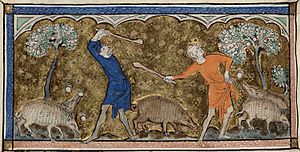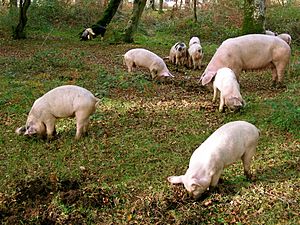Pannage facts for kids
Pannage is an old practice where pigs are let loose in a forest. Their job is to eat fallen acorns, beechnuts, chestnuts, or other nuts. This tradition was once very common across much of Europe. It was a special right given to local people who lived near common land or royal forests. In some parts of Europe, it had different names. For example, in German-speaking areas, it was called Eichelmast.
Contents
What is Pannage?
Pannage is basically a way of using pigs to clear up nuts from the forest floor. These nuts are a great food source for pigs. It's a natural way to feed them before they are ready for market. This practice has been around for hundreds of years.
Why Was Pannage Important Long Ago?
In the Middle Ages, pannage had two main benefits. First, as pigs rooted around for nuts, they also helped the soil. Their digging prevented the soil from becoming too hard. This released important nutrients for plants to grow better. Second, it was a simple way to fatten up pigs. This made them ready for slaughter and provided food for people.
The value of pannage was so high in some parts of England that it was used as a way to measure the worth of woodlands. For example, in the Domesday Book from 1086, some forests were described by how many pigs they could feed. Owners often had to give one pig to the lord of the manor as a fee for this right.
Pannage Today: The New Forest
Pannage is not common anymore in most places. However, it is still an important tradition in the New Forest in Southern England. Here, it is also known as common of mast. This practice is very important for the forest's ecology. It helps other livestock that live there, like ponies and cattle.
Why Pigs are Special in the New Forest
Pigs can safely eat a lot of acorns. But too many acorns can be poisonous to ponies and cattle. So, the pigs act like a clean-up crew. They eat the fallen acorns, which protects the other animals. This makes pannage a key part of how the New Forest is managed.
Rules for Pannage in the New Forest
The pannage season in the New Forest lasts at least 60 days. The exact start date changes each year. It depends on the weather and when the acorns fall from the trees. The Court of Verderers decides when the season will begin.
At other times of the year, pigs are not allowed to roam freely in the forest. There is one exception: special breeding sows, called "privileged sows." These sows can be out, but they must return to their owner's home each night. They also must not cause any trouble. To stop the pigs from digging too much and damaging the grass, they wear nose rings. These rings are clipped into their noses.



